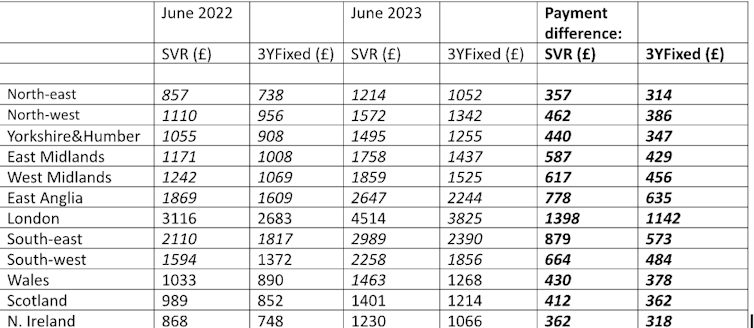
Millions of UK mortgage borrowers could experience significant payment shocks this year. This is happening due to a steep rise in the Bank of England’s base rate over the past year to the highest level since 2008. This rate feeds through to many of the mortgage deals taken out by homeowners around the UK.
To attempt to alleviate some of the pain for homeowners that will see large spikes in their payments this year and next, major UK lenders agreed to provide limited help to those struggling with the mortgage repayments.
Among other measures, lenders that participate will agree to allow borrowers to switch to interest-only payment terms or to extend the duration of their mortgage. Borrowers will be able to return to their original deal within six months without any impact on their credit rating. Lenders have also been asked to sign up to a 12-month repossession break to provide a grace period to people at risk losing their homes due to arrears.
But while these measures will help some borrowers, they could cause unintended consequences and create further mortgage payment issues. First of all, the Bank of England’s base rate is already expected to rise to 6% by the end of 2023 and could go higher next year.
Interest-only borrowers’ repayments only include the interest charged on the loan and nothing towards the principal amount. So, after six months (and at the same level of income), they could face much higher payment shocks. If rates are still relatively high after 12 months, many households could still be at risk of losing their homes.
There is also the question of which lenders will participate in mortgage rescue plan – it is a voluntary scheme. According to the FCA, around 75% of lenders will join. Those borrowers with nonparticipating lenders would not be able to use the grace period or other measures.
How mortgages differ by region
Another overlooked issue in the rescue plan is that, according to my research, households across the various regions of the UK will be affected differently by the mortgage crisis. Payment shocks will be amplified for those in the areas with higher house prices and higher average loan amounts.
The table below shows the difference in the increase in repayments for an average loan amount across the UK, based on different types of mortgage product. These figures show what repayments would have been in June 2022 versus June 2023, when the Bank of England had increased rates from 1.25% (for June 2022) to 5.00% (for June 2023) – repayments will be even higher if it goes to 6%, as expected by financial markets.
Repayment increases by region, June 2022 vs. June 2023:

The monthly mortgage repayments of households in London on standard variable rates (SVRs – the rate borrowers tend to automatically switch to after a fixed or tracker deal period ends) increased by £1,398 and by £1,142 for those on three-year fixed rate mortgages, for example. In the East Midlands, in comparison, average SVR repayments have increased by £587 and by £429 for three-year fixed rates since last year.
Taking current base rate changes into account, borrowers making interest-only mortgage payments will be even more exposed to future payment shocks when only repaying the interest on their principal loan amount. These borrowers will not have been chipping away at the equity part of their loans, like those on repayment mortgages, keeping their loan larger than it would have been if they hadn’t taken advantage of the rescue measure.
For the average principal loan amount of £250,000, for example, monthly interest-only repayments on the average UK SVR would be £587, compared to a total interest payment of £323 for a repayment mortgage (plus an additional amount towards paying off the borrowed amount, called the equity).
This is because when repayment borrowers pay interest plus equity, the total interest charged on a mortgage falls as the remaining debt decreases. So while repayment borrowers pay less interest as their equity builds and the principal debt falls, they still have to make higher payments overall.
So, for a three-year fixed rate deal, average total interest payments would be £497 per month for the six months for interest-only borrowers, compared to a similar repayment deal for which total interest payments would be £226. This means the exposure to overpayment when choosing to pay interest-only for the six-month rescue period would be:
- Three-year fixed rate 6x(£587-£323) = £1,584
- SVR: 6x(£497-£226) = £1,626
That is, choosing to pay interest only for six months could add at least £1,500 to a borrower’s bill over the life of the average home loan versus what they would pay if they remained on a repayment mortgage.
Regional differences will also come into play here when considering exposure to payment shocks and excessive mortgage payments. This is because households in regions with higher house prices borrow larger loans and so repay more over the life of the loan.
So, both base rate changes, but also the negative impacts of the mortgage rescue initiative will disproportionally affect households in areas with higher houses prices, such as London or East Anglia.

Searching for a solution
There is no straightforward solution to this situation, particularly since mortgage rates operate at the national level. A light-touch intervention, such as temporary caps on lenders’ profit margins could help. For example, if lenders were not allowed to make more than 2 percentage points above the bank base rate for certain mortgage products.
But the government also needs to consider the significant differences in payment shock levels across the country, particularly as it is likely to face a general election by January 2025, if not before. This is important when evaluating the robustness of the economy to recession, which already has an uneven effect on different locations and households.
![]()
Alla Koblyakova works as the Property Investment and Finance Course Leader at the Nottingham Trent University



